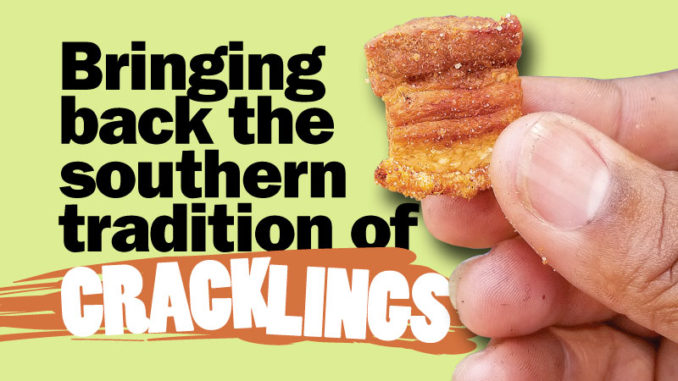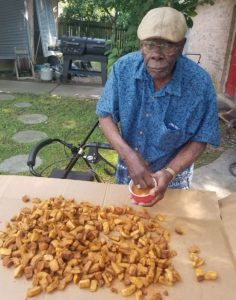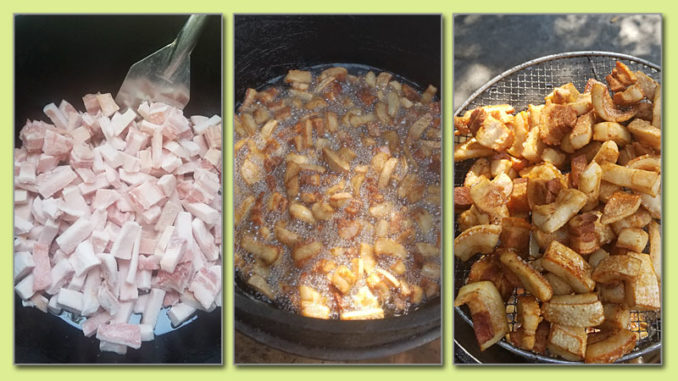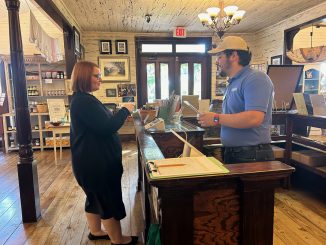
Displaying a freshly cooked golden crackling, David Diggs Sr. of Boutte admires the crunchy goodness of pork fat that he’s made since he was 12 years old.
“We were small, but you had to get out there and cut,” Diggs recalled. “All that kept the family going.”
Diggs also recounted how they saved the lard used in making cracklings to season other dishes like red beans or to rub it on chicken (fried or baked) for the rich taste. Frying chicken or shrimp in the oil “gave it a whole different flavor.”
Born on Aug. 13, 1933, Diggs is still making crackling, but readily clarifies the flavored lard is the best outcome, too.
“We raised the hogs,” he said. “We cut up the hog and cut up the fat to become cracklings. We used the back skin, keeping it cool to cut easier.”
In French, the butchering was called a boucherie and it often involved the entire family to help make the cracklings or grattons that became part of the tradition. The day began early because Diggs called it “an all-day job.”
Over time, the tradition nearly disappeared in his family and with others.
But Diggs’ grandson, Carlyn, who studied at Nicholls State University’s Culinary School, recalled how he helped make crackling a comeback in his family. He knew his grandfather was the go-to person on how to prepare the meat so they worked together .

“My parents showed me how to do it,” Diggs said.
When Carlyn’s uncle needed help with medical expenses, he suggested making cracklings as a fundraiser and it worked better than expected.
Carlyn led the effort.
He got a friend, also a butcher, to help with the meat and they pulled out the original cracklings cast iron pot, now nearly 30 years old, and seasoned it with grease.
“It holds a whole lot of heat,” Carlyn said.
They’ve since gotten 30-gallon, 50-gallon and 80-gallon pots to make them for family gatherings. A propane cooker keeps it hot and cuts cooking time, which he estimated reduced it from all day to nearly two hours depending on the weather.
Carlyn has gotten so much into cooking crackling that’s he called “Fat Man,” a title he’s proud of because it represents the pig fat he cooks. He also mused it represents the crunchy snacks – and they are increasingly desired for their freshness and authenticity. For example, a Fourth of July celebration – that once focused only on boiled crawfish – now also includes cracklings and the family tradition resumed. Out-of-state friends who had come down for the celebration were glad for the new taste and introduction to Louisiana culture.
“Skin to meat to the bone – all that is different flavor,” he said.
For crackling, once it’s fried for about an hour, Carlyn applies his own seasoning recipe, which includes salt, pepper, cayenne and garlic. But the rest is a secret – particularly what he calls the “kick” that keeps people coming back.
In cooking crackling, Carlyn added, “You’ve got to treat it like a baby. You can’t let it go.”

From there, making crackling has became a much bigger affair for him.
He bought a machine that screens the oil of meat or fat bits to avoid it burning the lard. It’s important, especially when they make “fried ribs” with pork baby back ribs, also cooked in the crackling lard, which he called a treat.
For Carlyn, he learned the pig meat parts at culinary school, but his learning to make crackling, not only bridged him into a cultural art, but also closer to his family. He said he also came to see preservation as part of the experience in taste, color and texture in today’s evolution of crackling making.
“There’s a lot of things you take for the new from the old,” he said. “It created a better bond between us.”

But Carlyn said today’s crackling is also about the art for the taste and eye rather than just salt and pepper.
Making cracklings, grattons, pork rinds or baconettes
- Use pork belly or pig skin.
- Cut it in bite sized bits or strips and fry them in lard for nearly an hour depending on the batch size.
- When golden brown remove from oil, a seasoning is typically added and then ready to serve when cool.





Be the first to comment